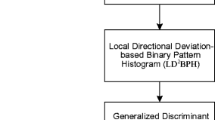Abstract
In this paper, a depth camera-based novel method is proposed to recognize several facial expressions from depth video. At first, Radon Transformation (RT) is done to extract features from the time-sequential depth faces that are further improved by Generalized Discriminant Analysis (GDA) to generate more robust features and then, Hidden Markov Models (HMMs) are applied to train and recognize different facial expressions successfully. Performance of the proposed facial expression recognition shows the superiority over conventional RGB camera-based approaches.










Similar content being viewed by others
References
Aleksic PS, Katsaggelos AK (2006) Automatic facial expression recognition using facial animation parameters and multistream HMMs. IEEE Trans Inf Secur 1:3–11
Bartlett MS, Donato G, Movellan JR, Hager JC, Ekman P and Sejnowski TJ (1999) “Face image analysis for expression measurement and detection of deceit”. In Proceedings of the Sixth Joint Symposium on Neural Computation pp. 8–15
Bartlett MS, Movellan JR, Sejnowski TJ (2002) Face recognition by independent component analysis. IEEE Trans Neural Netw 13(6):1450–1464
Boulgouris NV, Chi ZX (2007) Gait recognition using radon transform and linear discriminant analysis. IEEE Trans Image Process 16:731–740
Buciu I, Kotropoulos C and Pitas I (2003) “ICA and gabor representation for facial expression recognition”. In Proc IEEE 855–858
Calder AJ, Burton AM, Miller P, Young AW, Akamatsu S (2001) A principal component analysis of facial expressions. Vis Res 41:1179–1208
Calder AJ, Young AW, Keane J (2000) Configural information in facial expression perception. J Exp Psychol Hum Percept Perform 26(2):527–551
Chao-Fa C, Shin FY (2006) Recognizing facial action units using independent component analysis and support vector machine. Pattern Recogn 39:1795–1798
Chen F, Kotani K (2008) “Facial expression recognition by supervised independent component analysis using MAP estimation,”. IEICE Trans Inf Syst E91-D(2):341–350
Chen L, Wang YH, Wang Y, Zhang D (2009) Gender recognition from gait using radon transform and relevant component analysis. Lect Comput Sci 5754:92–101
Cohen I, Sebe N, Garg A, Chen LS, Huang TS (2003) “Facial expression recognition from video sequences: temporal and static modeling”. Comput Vis Image Underst 160–187
Deans SR (1983) The radon transform and some of its application. Wiley Interscience Publication, New York
Donato G, Bartlett MS, Hagar JC, Ekman P, Sejnowski TJ (1999) Classifying facial actions. IEEE Trans Pattern Anal Mach Intell 21(10):974–989
Dubuisson S, Davoine F, Masson M (2002) A solution for facial expression representation and recognition. Signal Process Image Commun 17:657–673
Ekman P, Priesen WV (1978) Facial action coding system: a technique for the measurement of facial movement. Consulting Psychologists Press, Palo Alto, CA
Hyvarinen A, Karhunen J and Oja E (2001) “Independent component analysis”. John Wiley & Sons
Iddan GJ and Yahav G (2001) “3D imaging in the studio (and elsewhere…)”. In Proceedings of SPIE 4298:48–55
Karklin Y, Lewicki MS (2003) “Learning higher-order structures in natural images,”. Netw Comput Neural Syst 14:483–499
Kim D-S, Jeon I-J, Lee S-Y, Rhee P-K, Chung D-J (2006) Embedded face recognition based on fast genetic algorithm for intelligent digital photography. IEEE Trans Consum Electron 52(3):726–734
Kotsia I, Pitas I (2007) Facial expression recognition in image sequences using geometric deformation features and support vector machine. IEEE Trans Image Process 16:172–187
Liu C (2004) Enhanced independent component analysis and its application to content based face image retrieval. IEEE Trans Syst Man Cybern B Cybern 34(2):1117–1127
Lyons MJ, Akamatsu S, Kamachi M and Gyoba J (1998) “Coding facial expressions with Gabor wavelets.” In Proceedings of the Third IEEE International Conference on Automatic Face and Gesture Recognition. pp. 200–205
Lyons MJ, Akamatsu S, Kamachi M and Gyoba J (1998) “Coding facial expressions with Gabor wavelets.” In Proc. Third IEEE Int. Conf. Automatic Face and Gesture Recognition, pp. 200–205
Meulders M, Boeck PD, Mechelen IV, Gelman A (2005) Probabilistic feature analysis of facial perception of emotions. Appl Stat 54(4):781–793
Mitra S, Acharya T (2007) Gesture recognition: a survey. IEEE Trans Syst Man Cybern Part C Appl Rev 37(3):311–324
Otsuka T and Ohya J (1997) “Recognizing multiple person’s facial expressions using HMM based on automatic extraction of significant frames from image sequences.” IEEE Int. Conf. Image Proc 546–549
Padgett C, Cottrell GW (1997) Representation face images for emotion classification. Adv Neural Inf Process Syst 9:894–900
Phillips PJ, Wechsler H, Huang J, Rauss P (1998) The FERET database and evaluation procedure for face-recognition algorithms. Image Vis Comput 16:295–306
Rahman MT, Kehtarnavaz N (2008) Real-time face-priority auto focus for digital and cell-phone cameras. IEEE Trans Consum Electron 54(4):1506–1513
Shen L, Bai L, Fairhurst M (2007) Gabor wavelets and general discriminant analysis for face identification and verification. Image Vis Comput 25:553–563
Singh M, Mandal M and Basu A (2005) “Pose recognition using the radon transform.” In Proceedings of the 48th Midwest Symposium on Circuit and Systems, 2: 1091–1094
Tian Y, Kanade T and Cohn J (2002) “Evaluation of Gabor wavelet based facial action unit recognition in image sequences of increasing complexity.” In Proc. 5th IEEE Int. Conf. Automatic Face and Gesture Recognition, pp. 229–234
Uddin MZ, Lee JJ, Kim T-S (2009) An enhanced independent component-based human facial expression recognition from video. IEEE Trans Consum Electron 55(4):2216–2224
Yu P, Xu D and Yu P (2010) “Comparison of PCA, LDA and GDA for palm print verification.” In Proceedings of the International Conference on Information, Networking and Automation, pp. 148–152
Zhang S, Zhao X, Lei B (2012) Robust facial expression recognition via compressive sensing. Sensors (Basel) 12(3):3747–3761
Zhu Y, De Silva LC, Ko CC (2002) “Using moment invariants and HMM in facial expression recognition.” Pattern Recognit Lett 83–91
Acknowledgements
The authors would like to extend their sincere appreciation to the Deanship of Scientific Research at King Saud University for its funding of this research through the Research Group Project no RGP- VPP-281.
Author information
Authors and Affiliations
Corresponding author
Rights and permissions
About this article
Cite this article
Uddin, M.Z., Hassan, M.M. A depth video-based facial expression recognition system using radon transform, generalized discriminant analysis, and hidden Markov model. Multimed Tools Appl 74, 3675–3690 (2015). https://doi.org/10.1007/s11042-013-1793-1
Published:
Issue Date:
DOI: https://doi.org/10.1007/s11042-013-1793-1




